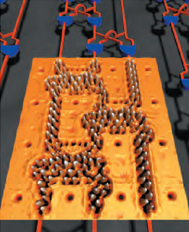True or False. Scientists can move single atoms with nanometer precision. A scientist can point to atom and move it from here to there. The answer? True. True or False, the year that the scientists first moved individual atoms was the same year that the first internet browser was invented. The answer? True.
The first group to move atoms was in 1989 and it was a feat accomplished by scientists at IBM. Don Eigler and his colleagues moved atoms using a special tool called a scanning probe microscope. This microscope was invented to ‘see’ atoms and it has a very sharp point like a needle. It ‘sees’ by moving close to surface and sensing the changes in the electrical field around the needle tip. They can’t really ‘see’ the atom or really even know what atom they are ‘seeing’. By moving the needle tip of the scanning probe microscope close to an atom they can drag it along from one place to another. 
What is really important is to cool the sample down to almost absolute zero (-459.67 °F or -273.15 °C) so that the atoms don’t move around too much. Then you also need a really smooth surface so that you can ‘see’ the atoms that you put on it. And finally you need to have just a few atoms, so all of the air inside your microscope is removed by a powerful vacuum. How powerful? There are fewer molecules in the atmosphere inside of the microscope than there are in space.
Some atoms are easier to move than others. So back in 1989, Eigler and his colleagues moved individual atoms of xenon. More recently they also started to play with molecules, like carbon monoxide. Using carbon monoxide, they have been able to create little logic gates (shown in the left picture), very small switches that work like dominoes. You line them up, and give the one on the end a flick with the needle point of your scanning probe microscope and then watch as one after another they jump to another place.
Image Source: Don Eigler

